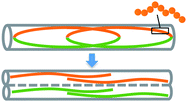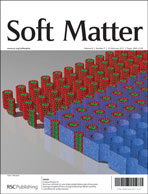Chromosomes in living cells are strongly confined but show a high level of spatial organization. Similarly, confined polymers display intriguing organizational and segregational properties. Here, we discuss how ring topology influences self-avoiding polymers confined in a cylindrical space, i.e. individual polymers as well as the way they interact. Our molecular dynamics simulations suggest that a ring polymer can be viewed as a “parallel connection” of two linear subchains, each trapped in a narrower imaginary tube. As a consequence, ring topology “stiffens” individual chains about fivefold and enhances their segregation appreciably, as if it induces extra linear ordering. Using a “renormalized” Flory approach, we show how ring topology influences individual chains in the long chain limit. Our polymer model quantitatively explains the long-standing observations of chromosome organization and segregation in E. coli.
You have access to this article
 Please wait while we load your content...
Something went wrong. Try again?
Please wait while we load your content...
Something went wrong. Try again?


 Please wait while we load your content...
Please wait while we load your content...